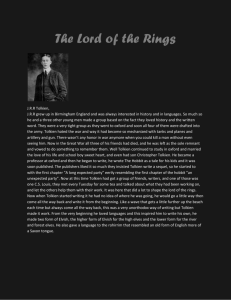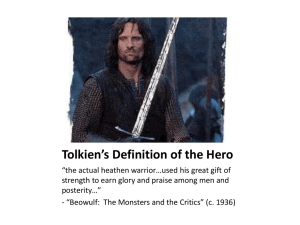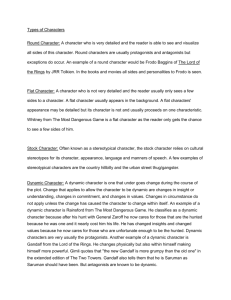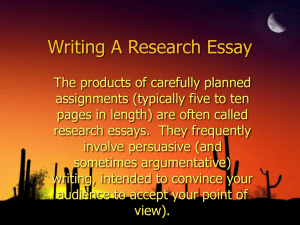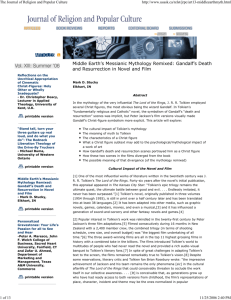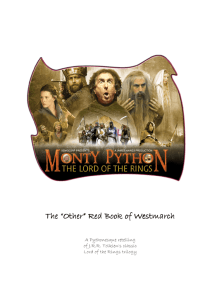The Rhetoric of Tolkien and Jackson`s The Lord of the Rings Trilogy
advertisement
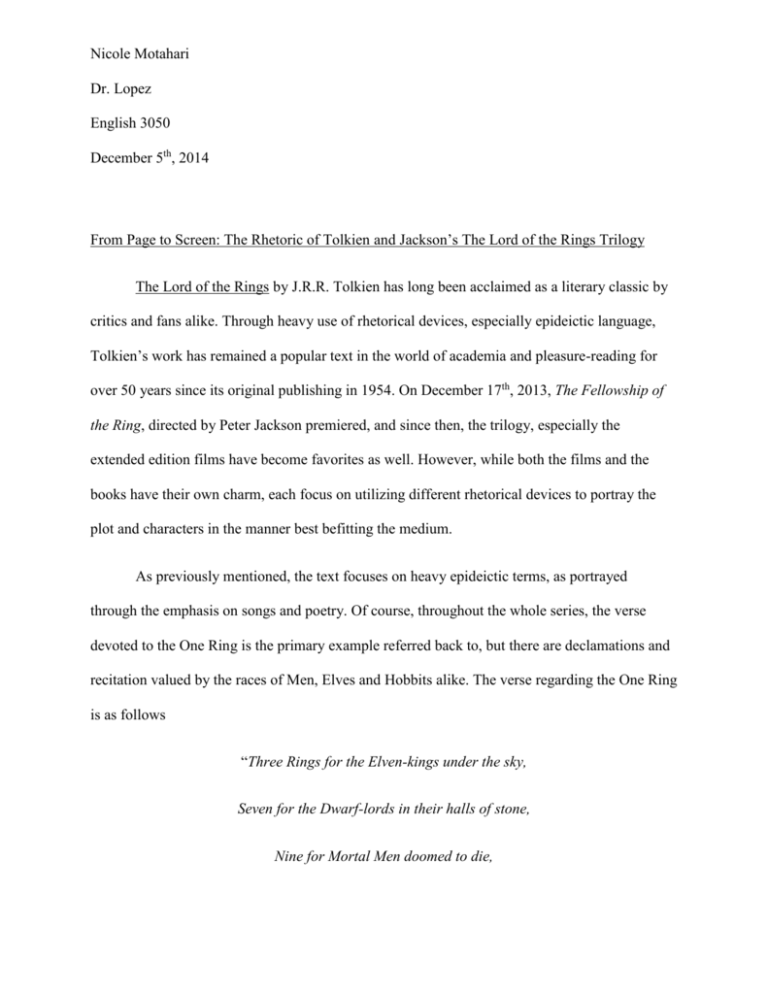
Nicole Motahari Dr. Lopez English 3050 December 5th, 2014 From Page to Screen: The Rhetoric of Tolkien and Jackson’s The Lord of the Rings Trilogy The Lord of the Rings by J.R.R. Tolkien has long been acclaimed as a literary classic by critics and fans alike. Through heavy use of rhetorical devices, especially epideictic language, Tolkien’s work has remained a popular text in the world of academia and pleasure-reading for over 50 years since its original publishing in 1954. On December 17th, 2013, The Fellowship of the Ring, directed by Peter Jackson premiered, and since then, the trilogy, especially the extended edition films have become favorites as well. However, while both the films and the books have their own charm, each focus on utilizing different rhetorical devices to portray the plot and characters in the manner best befitting the medium. As previously mentioned, the text focuses on heavy epideictic terms, as portrayed through the emphasis on songs and poetry. Of course, throughout the whole series, the verse devoted to the One Ring is the primary example referred back to, but there are declamations and recitation valued by the races of Men, Elves and Hobbits alike. The verse regarding the One Ring is as follows “Three Rings for the Elven-kings under the sky, Seven for the Dwarf-lords in their halls of stone, Nine for Mortal Men doomed to die, Motahari 2 One for the Dark Lord on his dark throne In the Land of Mordor where the Shadows lie. One Ring to rule them all, One Ring to find them, One Ring to bring them all and in the darkness bind them In the Land of Mordor where the Shadows lie.” (Fellowship 55). Interestingly enough, this rhetorical device specifically contains various rhetorical devices in itself. For example, the renowned two lines of the verse that state ‘One Ring to rule them all, One Ring to find them, One Ring to bring them all and in the darkness bind them’ are an example of anaphora, the repetition highlighting the importance of that One Ring, giving the readers an idea of exactly how important the simple gold band is, also providing support to Allison Milbank’s ‘Fetishization of the ring’ concept that the Ring is an object that becomes placed upon a pedestal of sorts, an object that is found “precious” to the holders, from Gollum to Isildur, Bilbo and even Frodo (Bassham, Bronson). Recitation is a large part of hobbit culture, and we see this in the references to Bilbo rhymes as well as Frodo and Sam’s recitations along the way to Crickhollow and Bree, especially. This is where there is a slight variation in rhetorical strategy between the books and films comes into play. While Tolkien uses poetry in the text, Peter Jackson and composer Howard Shore had to take the modern audience for the films into consideration. Going based off the general psychology, especially that of America, in a two hour (or even the extended three hour, 28 minute version), there is no time for the lengthy poems and stories utilized by Tolkien to set the mood for scenes in his books. Motahari 3 Instead, Jackson used music as a rhetorical device, having Shore compose different themes and even songs such as “Gandalf’s Lament” and “The Edge of Night”, also known as Pippin’s song in The Return of the King. Shore also went through great pains to ensure that proper languages were spoken in the correct places, emphasizing the different races and how they appear on-screen. For instance, in the Mines of Moria, the music used has dwarfish chanting, the syllables of the dwarf language rough and harsh, full of consonants, which reflects the earthy, rugged nature of dwarves (Howard Shore Interview). The use of diction characterizes each race on its own. For instance, the Elvish language is full of softer vowel sounds, which call to mind the ethereal, graceful traits that set the elves aside from the other races in the stories (Porter 156). Andrew Jack, the dialect coach for the films discussed how the region and the ancestry of each character affected the way they speak, and how all of the accents utilized in the films come from somewhere in the United Kingdom, which can be considered as an appeal to pathos, since the primary audience for the films was primarily from the U.K. Interestingly, based upon education and culture, the accents do vary. For example, Gandalf, the elves and the mouth of Sauron all utilize Rotarized English, which is the grammatically correct English taught in textbooks. However, most of the Hobbits speak with a slight Gloucestershire accent, suitable to their less educated upbringing, with the exception of Meriadoc Brandybuck and Peregrin Took, who were not raised in the Shire (Jack). The film also uses color extensively to provide the viewers a sense of the mood as well as in costuming to symbolize the character wearing it in an outward manifestation of certain key traits. Obviously, the most apparent examples of this come in the form of the Wizards’ names. This is emphasized in the books as well, though, of course, on screen it is pulled into prominence Motahari 4 with Gandalf’s reincarnation from Gandalf the Grey to Gandalf the White. Gandalf is known as Gandalf the Grey at the beginning of the trilogy, also called “Mithrandir”, or “the grey pilgrim” by Elves and Men. In the film, we see him cloaked in his grey pilgrim garb with the wizards hat atop his head and a grey oaken staff. This does match the description Tolkien gave Gandalf the Grey down to a tee, and can hold a variety of possibilities as to why the color grey could symbolize. For instance, grey can symbolize the smoke from Gandalf’s fireworks, his old age, but the meaning that seems to be stuck on the grey color is neutral. Gandalf the Grey is neutral, shepherding the Ring in the right direction, yet never fighting any battles. However, when he casts off his hat and cloak when fighting the Balrog, this seems to be the symbolic transition from Gandalf the Grey, neutral and plain to Gandalf the White, filled with the power of the Valar to take charge of the White council and replace Saruman, for his work on Middle Earth was not done yet (Drout). Gandalf comes back as the White Wizard, or Gandalf the White, some might say. This transition makes him more powerful in the movies, though in the book, we see that Gandalf’s power hasn’t increased, but rather he is replacing Saruman, who has fallen into treachery and darkness. The films actually portray Saruman’s part quite well in his costume and appearance by using his title of “Saruman the White”. White is supposed to represent purity, fairness and even innocence (perhaps in this case innocence is more so the lack of betrayal). However, if you pay close attention, you’ll notice that Saruman’s beard is not pure white, but streaked with grey and black, representing his sullied nature. His staff is black and sharp, made of cold metal, symbolizing his cold black heart. His white robe is more of an ecru, off-white color than pure white (Fenton). Motahari 5 In the book, upon Saruman’s betrayal, he is no longer white, as he tells Gandalf, “For I am Saruman the Wise, Saruman Ring-maker, Saruman of Many Colours… White… serves as a beginning. White cloth may be dyed. The white page can be overwritten and the white light can be broken,” to which Gandalf replies, “In which case, it is no longer what. And he that breaks a thing to find out what it is has left the path of wisdom”. Unlike Saruman in the film, Gandalf the White’s hair, staff and clothing are all pure white, giving way to the visual rhetoric Ngila Dickson, wardrobe designer for the film and Peter Jackson are utilizing to show that transition. When Legolas, Aragorn and Gimli find Gandalf in the woods, once he reveals himself, Legolas apologizes, saying “We thought you were Saruman”. Gandalf replies, “But I am Saruman, rather, Saruman as he should have been”, which indicates that he has returned renewed, pure and powerful. Another great part of the films is pathos in appealing to the audience’s emotions by emphasizing the on-screen emotions and relationships. Tolkien considered The Lord of the Rings a primarily hobbit-centric text, and so many of the relationships portrayed on-screen were relegated to the Appendices, such as the love story of Aragorn and Arwen. In the films, Arwen is the one who saves Frodo and orders the reforging of Narsil, the sword fated to defeat Sauron into Anduril, Flame of the West. Yet, in the books, Arwen doesn’t do much. She weaves Aragorn a tapestry with Gondor’s crest on it to inspire hope, but that’s it. By doing so, Peter Jackson strengthens the public’s emotions towards Arwen and Aragorn’s relationship, bringing in a strong female character as a romantic interest to allow female viewers especially a relatable character (Porter). Motahari 6 Another instance of this is Gimli’s attitude. The book Gimli is much more somber and holds his emotions inside. His grief is held inside at Balin’s tomb at Moria while the film Gimli is open with his emotions, crying loudly in Moria, hugging Aragorn at Helms Deep and wiping away a tear at the end of the film upon seeing the hobbits. Often used for comic relief, it’s different than the Gimli who is awed by Lady Galadriel and threatens to kill Eomer over his disrespect to her. He’s a teddy-bear, rough and gruff on the outside, but sweet and soft on the inside versus the stoic and strong character he is in the books (Porter). The film and the books choose to utilize a very different type of rhetoric. Perhaps it is because the various forms of media convey different messages. As shown by the emphasis on color, music and pathos, the rhetorical technique of the Peter Jackson films primarily revolves around manipulating the audience’s senses, utilizing more than one form to bring the written words to life on screen. The book series cannot use music that the reader can hear or tear itself away from the quest of the One Ring to expand upon emotions to the Appendices. Instead Tolkien utilizes poetry, songs, recitation and symbolism to convey to the readers the mood and meaning of his works, a darker tale than that told on screen, yet every bit as powerful and rich as the film. Motahari 7 Works Cited Bassham, Gregory, and Eric Bronson. The Lord of the Rings and Philosophy: One Book to Rule Them All. Chicago: Open Court, 2003. Print. This book is part of a scholarly series examining popular culture and philosophy. I would classify it as especially reliable, since it was procured from the public library, and therefore had to pass a further level of scrutiny than if it were merely published online. While it does not directly examine rhetorical devices in The Lord of the Rings, it contains some general themes that I might use to narrow down the rhetorical analysis of my essay. I’m using this almost as a starting block, in hopes of picking a specific theme to address the rhetorical analysis towards, particularly the chapter regarding the ‘fetishized Ring’, since Bilbo, Frodo and Gollum are all at some point obsessed with the Ring, and the book addresses that obsession with objects in the original novel. I think it would be interesting to analyze the rhetorical devices Tolkien uses to portray that objectification and strong symbolic power of the Ring over Middle Earth. Day, David. Tolkien: A Dictionary. N.p.: n.p., n.d. Print. This book is simply a great resource as a reference. It doesn’t hold any literary-themed or rhetorical content, but instead is a dictionary that definitions may be pulled for support in the paper, since one theme we explored in class in making writing suitable for a broader, more diverse audience to read, and since this text provides insight into Tolkien’s fantasy world of Middle earth, specific terms such as ‘Orcs’ and ‘Ents’ may be defined in terms, allowing readers who may have only a brief understanding of the text to more fully appreciate the concepts and characters being explored in the paper. This text calls upon multiple Tolkien encyclopedias as Motahari 8 sources used to create this briefer dictionary version, so I can tell the author has done extensive research, and is therefore reliable to utilize. "Howard Shore on The Lord of the Rings | Soundtrack." Soundtrack. N.p., n.d. Web. 05 Dec. 2014 This was a great resource in that it was a primary source- an interview from the composer of the score for the Lord of the Rings explaining his experience creating the songs and score. It goes into depth discussing each race, character and relationship. He discusses featured music as well as background music. Drout, Michael D. C. "Tolkien's Prose Style and Its Literary and Rhetorical Effects." Tolkien Studies 1.1 (2004): 137-63. Web. Michael Drout’s article provides an insightful rhetorical perspective on the original text, while also relating it to classic literature such as King Lear. I find this fascinating, since this is the approach I’d like to take in my career. His article is in a peer reviewed journal, and is therefore well suited for me to use in the research paper. I would like to find more sources like this, but there are few to find. The article has been used as a source for multiple other research papers on the web, and Michael Drout is a well-known professor in his field, and is recognized as a Tolkien expert. Fenton, Carolyn. "Costumes." The Lord of the Rings. New Line Cinemas, n.d. Web. 05 Dec. 2014. This was a very reliable source, since it was straight from the film site. Again, this is a primary source in the form of an interview. Great with discussing costume symbolism and evolution. Motahari 9 Porter, Lynnette R. Unsung Heroes of the Lord of the Rings: From the Page to the Screen. Westport, Conn: Praeger, 2005. Print. This book concentrates on the supporting characters in Lord of the Rings and their journeys and growth through the tales. If I choose to pursue an analysis of rhetorical analysis of a specific character and following their development through the books, then I will likely utilize this text in that path. It’s a great read either way because not only does it describe how the characters developed in the books, but also in the films, and it even provides diagrams and tables to point the two as far as similarities and differences. An interesting topic to take would be analyzing the rhetoric used in the film versus the rhetoric used by Tolkien himself. Tolkien, J. R. R. The Lord of the Rings. Boston: Houghton Mifflin, 1994. Print. This is the primary text of The Lord of the Rings, which obviously, will be used for analysis. I’ll be taking a rhetorical approach to the text and am currently working on narrowing that down to rhetorical analysis in regards to a particular topic. It’s a bit tough, but I’m down to two or three specific topic and am gathering textual support for these various topics so that I may settle on a single idea before the break and work on furthering that for my research paper.


